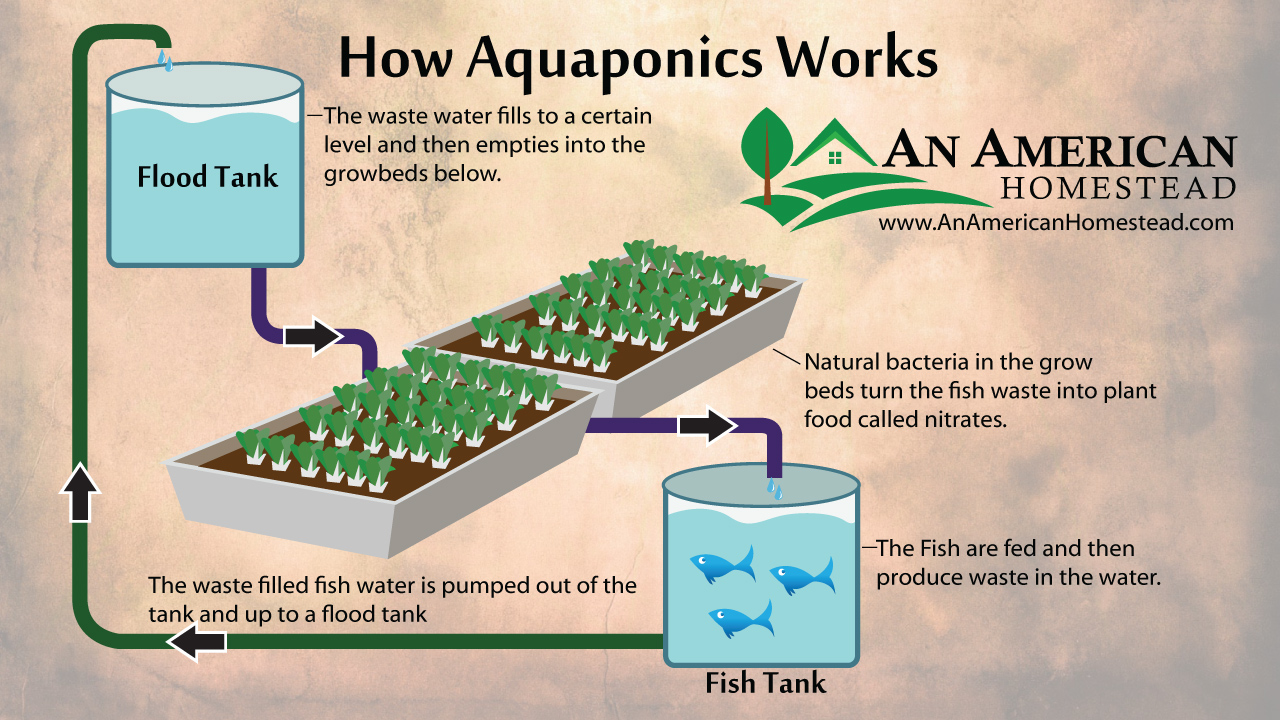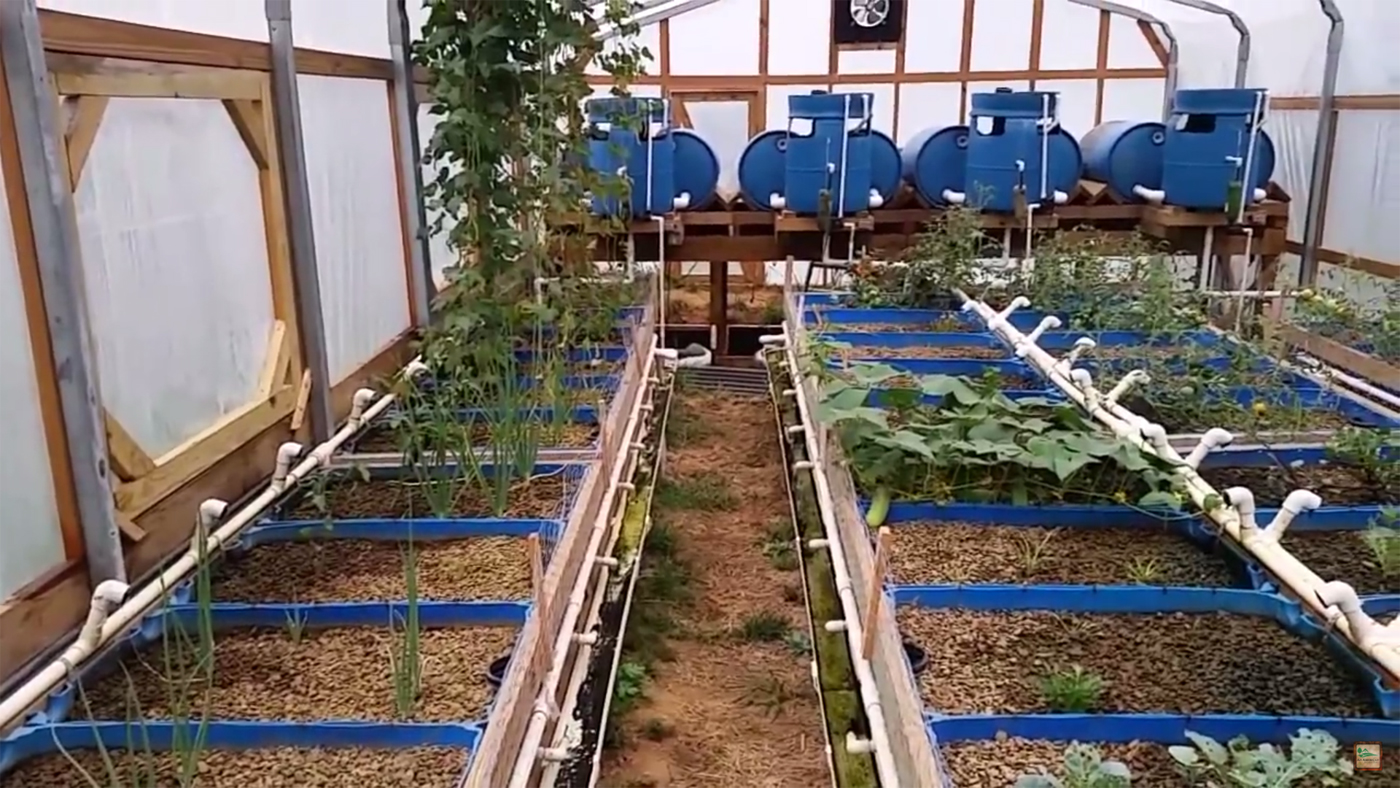Why My AQUAPONICS Didn't Work OFF-GRID - Homesteading and Alternative GROWING METHODS 📷 [PICTURES inside]
Will This Work For Your Homestead?
Our system in a nutshell
Four years ago we went through some considerable expense to build a 20x40 greenhouse that would contain a very large aquaponics system. The fish tank capacity was 1000 gallons divided into 4 different tanks. Each tank serviced its own set of grow beds made of barrel halves.
Each of the 4 fish tanks had its own pump system that was powered by 1000 watts worth of solar panels.
How does Aquaponics Work?
Aquaponics and how it works is actually very simple. Fish live and grown in a tank where daily they contribute their body waste. The water from that fish tank is pumped out every hour and flows over a set of grow beds where plants are growing. The grow beds full of helpful bacteria are constantly breaking down the fish waste into usuable nitrates and nitrites that can be absorbed and used by the plants growing in the beds. What you end up with is a perfect ecosystem of fish supporting plant growth and bacteria filtering out water that in turn returns clean back to the fish tank. It works wonderfully.
We ran our system for 3 years with the best growth happening in year 2 and 3. It takes a full year for the bacteria in the grow beds to get established and so it's slow going at first. But you can still grow lots of leafy greens as they don't require a lot of dense nutrients like other plants do that grow heavy produce.
Year 2 and 3 saw fantastic results at growing sweet corn, loads of delicious peppers, tomatoes, cucumbers, spinach varieties, peas, onions and lots more. We were very impressed with how the system was working out.
Growing The Fish
Aquaponics has the added benefit of growing fish. Most people in warmer climates or with climate controlled facilities will usually choose Tilapia simply because you get the quickest bang for your buck. A tilapia fish will grow into an adult sized fish in as little as 10 months with a regulated high protein diet. This was our first hurdle we had to overcome.
Because we are off grid, we could not keep the tanks warm enough, long enough to keep tilapia alive. We are technically in the south of North American but not south enough. Temperatures will sometimes drop below 0 degrees Fahrenheit and -17 Celsius during the winter months. It's not often but it does happen. Tilapia will die when the water temperatures reach below 59 degrees Fahrenheit or 15 degrees Celsius.
So instead of Tilapia, we chose to grow hybrid bluegill fish. Hybrid bluegill are a natural cross between a bluegill and a sunfish. The result is a very large fish but it takes about 2 years to reach the large size you will want to harvest.
Why It Didn't Work Off Grid
The biggest issue was that the water consumption was too great. When the system is at peak performance, you basically have 1000 gallons of water in the fish tanks. And you have another 150 gallons spread out in the flood tanks or grow beds at any given time.
When the temperatures in the green house reach 90 degrees Fahrenheit or above, the water evaporation becomes so great that you basically are losing an average of about 250 gallons of water each week. Now that many not sound like a lot of water but when you remember that our water sources are two ground wells that will run low in the peak of summer, that then becomes a big problem.
An on-grid operation will not have a problem and can refill the water being lost. But for us, it meant to have to transfer about 250 gallons of water each week in summer to top off the fish tanks and keep the system running. Many times our wells cannot handle that kind of water transfer on a weekly basis and support the homestead water needs in other areas.
The Fish Problem
The other issue was the fish and this can simply be tossed up to the learning curve. At first we over stocked our tanks with 75 bluegill in each tank. This was way too many. As they grew, each fish and its oxygen consumption began to grow as well and pretty soon, there was not enough oxygen to support the fish population even with air stones working in the tank. They were getting by ok and then one night a mouse chewed thru the plastic air hose that goes out to the tanks and by morning, we had a massive fish die off on our hands. So we had to start again. The solution, don't overload your fish tanks.
What Will We Do Now?
The plan is to remove 3 of the 4 grow bed sections and fish tanks. We will keep one in operation next year to sprout seeds to be transplanted. But the rest of the greenhouse will be used to grow fig trees starting next spring.
Conclusion
Don't get me wrong. Aquaponics works! It works amazingly well, however it's better suited for an on grid situation that has plenty of access to water in case of evaporation. It also has a lot of fail points. Meaning that if any one thing fails, you could have a disaster on your hands if you don't catch it in time. So I would consider it high-medium maintenance. It requires your daily attention. Checking on your system once or twice a day is fine but you need to keep an eye on it nonetheless.
HAPPY GROWING!
Have you tried aquaponics? What was your result and experience? Post a comment below and let us know.

Visit Us Online: http://AnAmericanHomestead.com








Great concept butI see it needs daily maintenance and supervision. The system works but there is also a lot of variables that come in that can affect results. The system needs a controlled setting with monitoring and supervision to account for variable factors that can set in.
One day a pvc line came apart and allowed the water for the grow beds to leak out and empty the fish tanks. I caught it in time but if i hadnt......
I've been 'planning' my aquaponics for at least two years now. I thought I might try it out with something small. Maybe a small indoor setup with pet fish and some herbs. Then once I get the hang of it, increase in size. Thanks for sharing your experience.
My personal experience has been that larger systems are easier to maintain. My largest system has a 500 gallon fish tank, 200 gallon sump, 150 gallon radial flow filter, and a 4’ wide by 32’ long deep water culture bed. It uses goldfish as the growing engine and it produces 72 heads of lettuce per week.
We are planning our greenhouse and aquaponics setup now, and hoping to being the build by early fall. I am planning to have a "red neck" geo-thermal setup in the slab of the greenhouse, to help with the winter heating. I will likely have a wood burning stove also.
I am planning to power the Aquaponics with Solar, although we do have power available, I plan not to use it if I can manage it. We also have water available. Do you have any pointers or suggestions that I should keep in mind before building this out, or during the startup of the system?
Not sure where you are located but if its north of me, have a barrel stove installed in you greenhouse. It worked great and was cheap.
Great read. I just came to your page because I notice that you upvote my content pretty often. I figured that I come to your page and see what you're about. Great content indeed. Followed/upvoted!
Thanks jetiknight. Love your bitconnect vids. Found you through craig.
I appreciate that man. Slowly but surely will be expanding the content as I kinda settle in with Steem and getting to know my audience more. :-)
Nice post! Up-voted and followed! Check out our recent post on aquaponics, we all got to support the gardening community! https://steemit.com/life/@steemtobefree/one-hell-of-a-way-to-grow-the-best-food-our-trip-to-the-aquaponic-ouroboros-farms-in-half-moon-bay-california
Thanks! I'l check it out!
what about aquaponics on a barge?
THAT'S IT!
just wondering
I'm rebuilding a houseboat.
it could push a barge.
I have been using aquaponics for 7 years and have to agree off grid on large scale is tricky and I think the best way to go is on grid. I have killed off lots of fish trying different methods including airlift pumps, solar power, and combination of both. Back up power is a must and yes you have to watch your system close because stuff happens. I still prefer over dirt gardens thou
There is no doubt in my mind that aquaponics beats dirt any day of the week and twice on sunday. Like you said, it's just tricky off grid and for me more than I can do with everything else on my plate. If I had on grid water, I could handle it.
Nice article followed you hop u follow back and check out my blog
Hey Zak. Would something like a Kratke method work in the greenhouse? It uses much less water and is pretty easy maintenance. And I would think you have plenty of resources for compost tea. It worked great for me for leafy greens albeit on a much smaller scale. Mhpgardener has some great info on his channel.
good stuff rusty